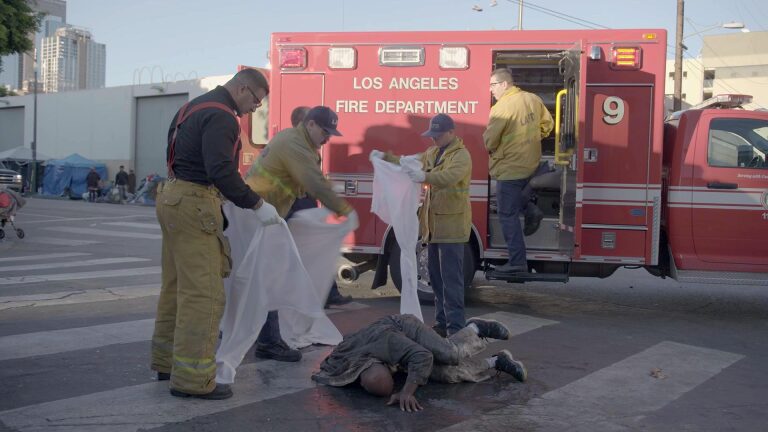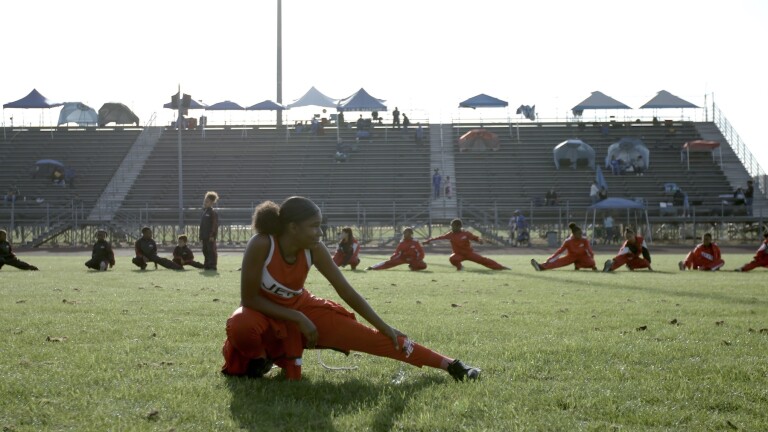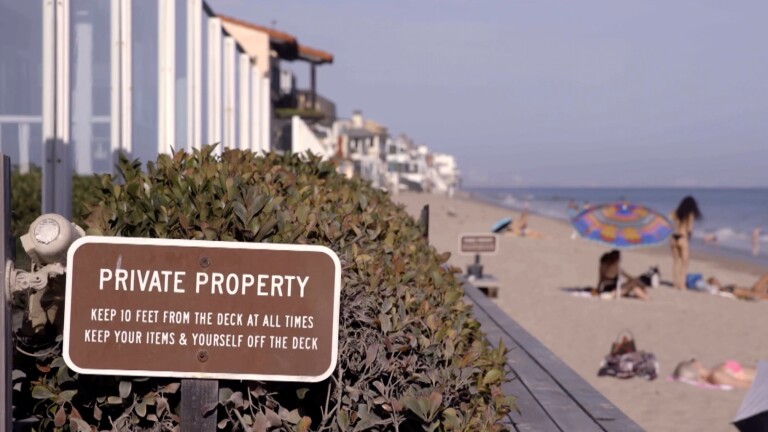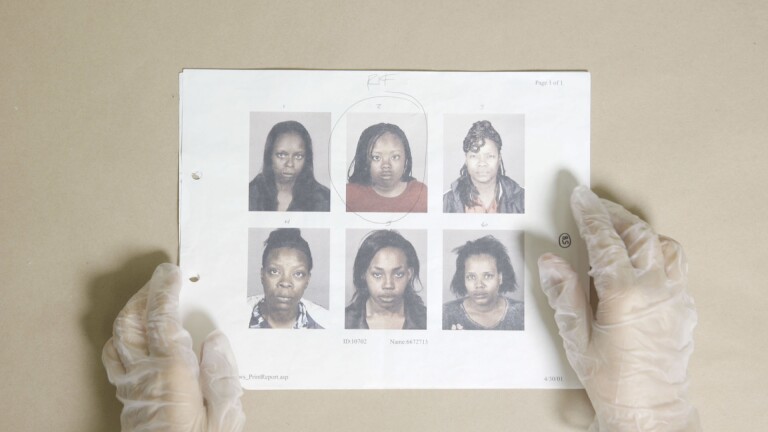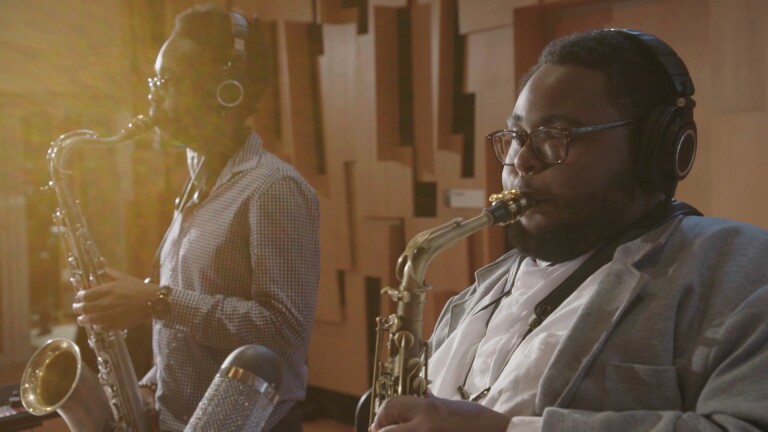
Tourist Detraction
It's more famous than the Walt Disney Concert Hall, Venice Beach or even the Sunset Strip. It's the Hollywood sign. But for the people living nearby, this tourist attraction has become a distraction. Correspondent Brian Unger heads to the Hollywood Hills to see how these nine white letters are spelling trouble.
TRANSCRIPT:
Brian Unger: In this whole big world of well-known man-made monuments, sure, there are towers, some great walls, and bridges, but only we have a sign.
The Hollywoodland sign was first installed on Mt. Lee as a promotional tool in 1923 to lure folks to come live in the virgin hills above Franklin Avenue. Though only supposed to last a year and a half, the sign became city property in 1939. They dropped a few letters, and an icon was born!
And like the pyramids, the Coliseum, or the Vatican, the sign has beckoned travelers to experience its nine-lettered splendor up close. But for years the disturbingly windy, narrow streets — and the lack of clear directions to negotiate them — prevented even the most intrepid sightseers from getting too close.
Then, something revolutionary happened — internet maps peeled back the mystery of how to get to the sign.
Next came portable GPS for the masses. And from Hollywood to Bollywood, people began to hear voices, and simply followed them.
Sarajane Robinson Schwartz/Homeowner: To get there, they have to go through our neighborhood with its almost hundred-year-old streets, substandard, narrow, blind-curve streets to get there. And we just can't handle all of these people, and it’s very dangerous when these streets start gridlocking.
Unger: Sarajane Robinson Schwartz heads the Hollywoodland Homeowners Association. Her camp, the HHA, is not happy.
Schwartz: Every day I see tourists in the middle of the street, particularly in some of the areas where there are very narrow, blind curves, who are outside or their cars parked there where they’re not supposed to park, signaling you to go around them, you know, into a blind curve where you don’t know what’s coming from the opposite end, and they’re endangering themselves and the residents here.
Unger: Sarajane and I hit the road together.
Schwartz: On the map this is called a major road.
Unger: A major road on the map that the city gives out.
Schwartz: Yes.
Unger: Indeed, streets are twisty, blind, narrow, and unforgiving to the unfamiliar. Need a tourist from Dusseldorf to back up and let an emergency vehicle pass? Well, that could be tricky. Multiply that problem and a host of other "what-ifs" by a hundred, every day, and it starts to get dangerous.
Schwartz: So imagine if you had cars all along here parked. I’ve had about 20 to 30 cars parked —
Unger: Reducing this road to a single lane.
Schwartz: A single lane!
Unger: Add lame signage to crumbling roads, and even the tourists get a little bent out of shape.
Unger: Are you here to see the sign?
Tourist: Yeah, yeah. I think there should be some other way to go towards it.
Unger [to tourist]: You think there should be some other way to go? It’s a little hard to navigate, right?
Tourist: Yeah, yeah.
Unger: Have fun. Good luck.
Unger: But they don’t just come in cars. There are hordes of airborne visitors flying at low altitudes over the sign in helicopters, which is driving residents crazy — to the point where the FAA now might get involved. And then there are the ubiquitous Hollywood tour buses. It’s high time I took a ride in one of those.
Unger: Believe it or not, as a tour guide driver, the first thing you have to look out for is, well, tourists.
Unger [to driver]: What’s that guy doing? He seems to by lying down in the street.
Driver: This guy’s taking pictures. As you see, people don’t care about the cars.
Unger: And then there are the streets.
Unger [to driver]: How do you drive on these streets, they’re so narrow? You gotta be really good.
Driver: You gotta be sober too. You have a few drinks and it's gonna be tough to get up here.
Unger: And of course, the natives.
Unger [to driver]: Do you find that the people who live up here are nice to you?
Driver: Some of them are nice, but again — some of them, you know?
Unger: Not all of them?
Driver: They never expect to have this kind of traffic up here, you know?
Unger: Have you had words with tourists yourself?
Fran Reichenbach/Local Resident: Not negative words. We like ‘em. They’re wonderful people. It’s not their fault that we’re not being responsible enough to guide them to a nice wide spot in the road to take a picture.
Unger: That’s 28-year resident Fran Reichenbach. She's president of the Beachwood Canyon Neighborhood Association.
Reichenbach: Any other city across the planet that has a national icon in it, you come into the area, you can see some signs that kinda tell you. It’s pretty easy, pretty straight ahead. Go here, take picture, leave. We have no such thing, so what you get is a lot of confused tourists. Everything in their GPS said that they should be able to actually go drive right up to the Hollywood sign.
Unger: Her camp has a website, thehollywoodsign.org, that she says offers accurate information to visitors who want to experience the sign.
Reichenbach: We’d like to show you some other wonderful opportunities on where you can take a picture of the Hollywood sign without having to go through this gridlock and neighbors waving their fists at you or honking at you or yelling at you or whatever.
Unger: For answers, naturally, we turned to L.A. City Councilman Tom LaBonge, who presides over this neck of the woods, and the sign.
LaBonge: This is all park behind me, but it butts right up to the neighborhood. So there's a little conflict now with technology, because GPS on the dash of any rental car puts you right here in the driveways of the people who live here.
Unger: Yup.
LaBonge: One community group that has a long history here says this should be the vista that we direct people to by signs. Another neighborhood group doesn’t like that.
Unger: Uh-huh. And so...
LaBonge: Let the dust settle. I mean you could have all these emotions but being in the middle, you kind of let the dust settle. I don’t want to discourage people from their involvement or engagement. I'm trying to solve this problem. I know I won't make everybody happy, but I do know this is public space. And I do know that it’s important to know that the public, and our tourists are the public, have to be welcomed but also be organized in a proper manner.
Woman Using Voice-Activated Cell Phone: How do I get to the Hollywood sign, Siri?
Unger: Let's see what she says...
Cell Phone Voice: I'm really sorry about this, but I can't take any requests right now.
Unger: Other than a designated vantage point, what seems to elude everyone, including this reporter, is someone, anyone, with a real solution.
LaBonge: Most sensible middle-of-the-road solution is get someone who, like you, good-looking, tall and get a uniform on him like a little ranger. And be here so when people are in the street, encourage them to get out, make sure they're not smoking.
Unger: Someone like me to keep this landmark accessible and safe for everyone? Well, as I said, citizens here deserve a real solution. But in the interim, I’m Brian Unger, ready for duty.

